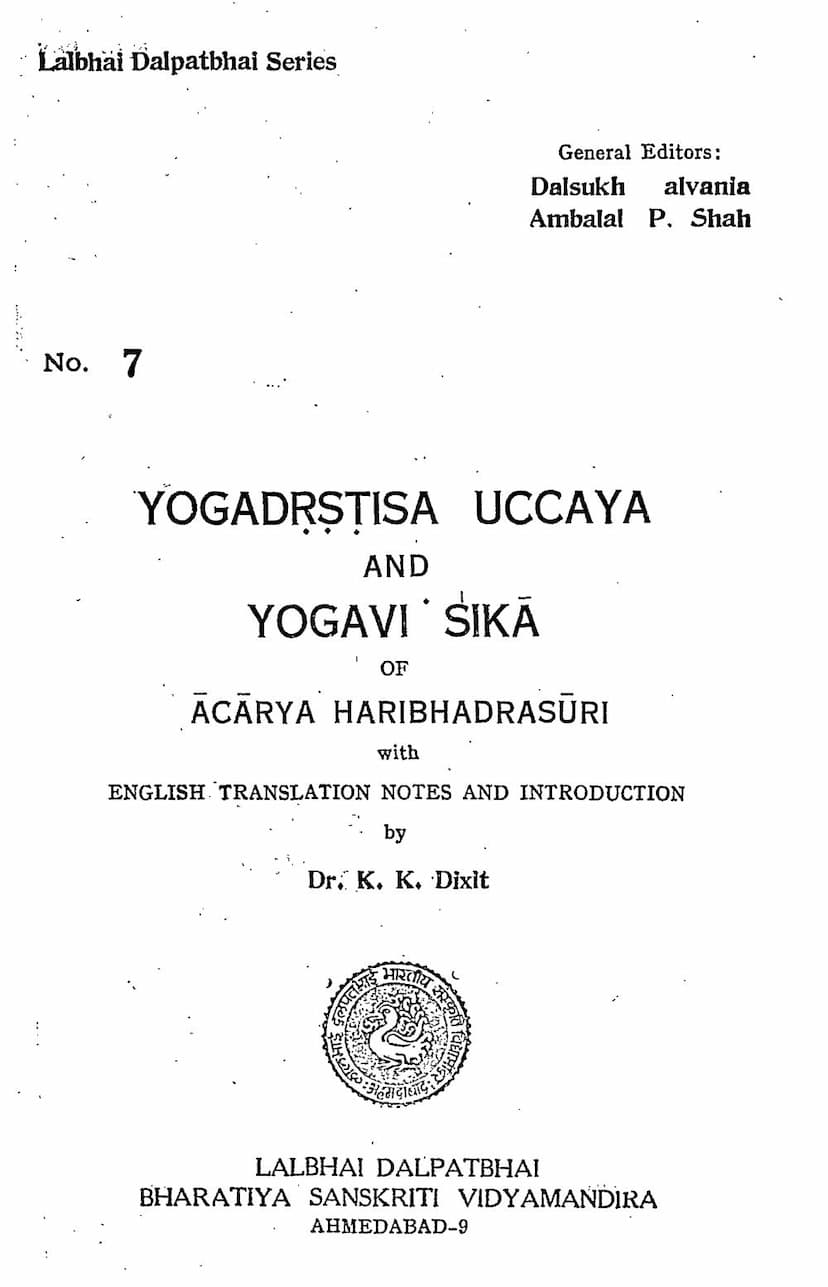Yogadrstisamuccaya And Yogavinshika
Added to library: September 2, 2025

Summary
This is a comprehensive summary of the Jain text "Yogadṛṣṭisamuccaya and Yogaviṁśikā" by Ācārya Haribhadrasūri, translated and edited by Dr. K. K. Dixit, and published by L. D. Indology, Ahmedabad.
Overall Context and Significance:
The book presents two important works by Ācārya Haribhadrasūri, a prominent Jain scholar. The Yogadṛṣṭisamuccaya (Collection of Yoga Viewpoints) is a major work, while Yogaviṁśikā (Twenty Verses on Yoga) is a shorter, Prakrit work. The translation and notes by Dr. K. K. Dixit are highly valued for making these complex texts accessible to a wider audience, particularly for comparative studies of Yoga across different Indian philosophical schools. Haribhadrasūri is noted for his remarkable freedom from theological sectarianism, which is a significant feature of his writings.
Yogadṛṣṭisamuccaya:
The central theme of the Yogadṛṣṭisamuccaya is the human journey towards ethical perfection and spiritual liberation (mokṣa). Haribhadrasūri attempts a novel spiritual gradation, dividing the spiritual evolution into eight stages or "yoga viewpoints" (dṛṣṭis). This framework is influenced by, but not identical to, similar concepts in Buddhist literature. Haribhadra uniquely integrates concepts from Patanjali's Yogasūtras (eight yogāṅgas), Bhadanta Bhaskara's eight virtues, and Bhagavaddatta's eight freedoms from undesirable traits.
Key Concepts and Structure:
The work is structured into several sections, detailing Haribhadra's philosophical approach:
-
Introduction (Sections I-II):
- Haribhadra's primary concern is the development of an "ideal human personality," which he considers a prerequisite for attaining mokṣa. He defines yoga broadly as "that which is conducive to mokṣa."
- He critically engages with traditional Jain positions, particularly the concept of guṇasthānas (stages of spiritual progress).
- He contrasts the traditional Jain view, which emphasizes the eight types of karmas and their influence on guṇasthānas, with his own focus on the mohanīya-karma (karma causing delusion) and its impact on ethical conduct and spiritual outlook.
- The Yogadṛṣṭisamuccaya introduces an eight-fold classification of yoga viewpoints: Mitrā, Tārā, Balā, Diprā, Sthirā, Kāntā, Prabhā, and Parā.
- He classifies the first four viewpoints (Mitrā to Diprā) as characterized by avedyasaṁvedyapada (lacking subtle understanding and potentially prone to degeneration) and the last four (Sthirā to Parā) by vedyasaṁvedyapada (possessing subtle understanding and being more stable).
- Haribhadra critiques "logic-chopping" and "theological sectarianism," advocating for a unified approach based on belief in mokṣa and omniscience. He argues that true understanding comes from scriptures, reasoned inference, and yogic practice, not solely from dry logic.
- He discusses the nature of mokṣa, refuting absolute momentarism (Buddhist) and absolute eternalism (Sankhya), and reiterating the Jain perspective that mokṣa is the soul's attainment of its pure, unconditioned state, free from the bondage of karmas.
-
Detailed Breakdown of Yoga Viewpoints:
- First Four (Mitrā to Diprā): These stages are associated with a nascent religious consciousness, but with limited understanding (Diprā specifically lacks subtle understanding). They are also characterized by a susceptibility to spiritual decline.
- Last Four (Sthirā to Parā): These represent higher stages of spiritual development.
- Sthirā: Characterized by permanence, control over senses, and freedom from illusion and sin.
- Kāntā: Builds upon Sthirā, adding a focus on benefiting others and developing a more refined understanding.
- Prabhā: Marked by liking for meditation, freedom from spiritual ailments, acceptance of true principles, and a predominantly calm mind.
- Parā: The highest stage, characterized by supreme meditative concentration (samādhi), detachment, natural conduct, and ultimately, the renunciation of virtues leading to liberation. This stage aligns with the ultimate goals of yogic practice.
-
Transitory Sections: These sections bridge the gap between the first four and last four yoga viewpoints. They include a critique of the "welcomer of worldly existence" (those lacking proper understanding), a denunciation of logic-chopping, and a plea against theological sectarianism.
-
Nature of Mokṣa: Haribhadra elaborates on the Jain understanding of mokṣa as the soul's liberation from the cycle of birth and death, achieved through the eradication of karmic bondage. He argues against simplistic interpretations of existence and non-existence, emphasizing the soul's inherent, unchanging nature.
-
Concluding Remarks: Haribhadra offers miscellaneous concluding thoughts, including his own reflection on compiling the work for self-remembrance, and identifying different types of yogins (kulayogins, pravṛttacakrayogins) and their corresponding qualifications and practices. He also touches upon the importance of yamas (ethical restraints) and favorable circumstances for spiritual progress.
Yogaviṁśikā:
This Prakrit text complements the Yogadṛṣṭisamuccaya by providing a concise overview of Haribhadra's understanding of yoga.
- Definition of Yoga: Haribhadra defines yoga broadly as any "pure religious performance conducive to mokṣa." He distinguishes between five types of yoga:
- Sthāna (bodily pose)
- Ūrṇa (utterance of chants/mantras)
- Artha (grasping the meaning)
- Ālambana (concentration on gross objects)
- Anālambana (concentration on subtle objects, especially the activities of a liberated soul)
- Gradation: Each of these five types is further divided into four sub-types: iccha (desire), pravṛtti (practice), sthira (steadfastness), and siddhi (accomplishment).
- Spiritual Progress: Haribhadra emphasizes that true yoga is practiced by those who have progressed spiritually (desa-caritrin and sarva-caritrin). Mere acquisition of knowledge is considered the "seed of yoga," not yoga itself.
- Critique of Improper Practice: He strongly criticizes improperly undertaken religious observances, arguing they can lead to the downfall of religious tradition and the individual.
- Connection to Mokṣa: The anālambana type of yoga, particularly the siddhi sub-type, is presented as directly leading to the cessation of delusion (moha), the completion of spiritual progress (śreṇi-ārohaṇa), omniscience, and ultimately, mokṣa.
Overall Contribution:
This volume, through Dr. K. K. Dixit's scholarly translation and insightful commentary, provides a deep understanding of Ācārya Haribhadrasūri's significant contributions to Jain philosophy and the broader Indian discourse on Yoga and ethics. Haribhadra's emphasis on an inclusive, non-sectarian approach, his detailed classification of spiritual stages, and his nuanced understanding of yoga as encompassing the entire ethical and spiritual life are highlighted. The work is invaluable for scholars interested in comparative religious and philosophical studies.